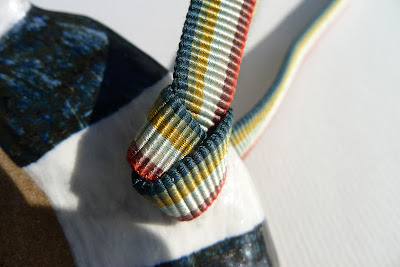
 |  |
 |  |
 |  |
The hanabue are signed by a gorgeous little hand-painted logo.

 |  |

---
The Large Okan-Khamen

 |  |

The back of the flute is very « organic », and really looks like the back of an animal (a bit like a ray fish bottom side). It is totally shaped by hand but the technical parts (the "flute" itself) look very precisely made however, with a funny but very useful nose-shaped cavity to plug comfortably your snout.
The air exit draws a very thin line, and the labium, very narrow in width (but large in height), is regular and sharp. Both are quite well made for a hand-made clay flute.

 |  |

 |  |
The Small Okan-Khamen

The "small" Okan-Khamen flute is the inhabitant of a book! Love of Life, by Jack London (here as a thick book — the original text is 16 pages long:) — serves as a craddle/sarcophagus for this little pharaoh. The book is very well done, with a magnetic cover, hollowed out in the inside. A thick "first page", stamped with phonetic Japanese (first word is "hanabue" = nose flute) and cut by an oval window, let the baby breathe and can be removed to access to her.
I love this japanese mind where you do not access to the treasure immediately: it is hidden, as in the traditional house Toko-no-ma or in the miso soup filling a lacquer bowl that has acquired a venerable patina [If you never read it, you should : Tanizaki Junichiro (谷崎潤一郎), 陰翳礼讃, In Praise of Shadows]. Sorry, I made these pictures in the sunlight! :

 |  |

The flute itself is a reduced model of the large one (or is it the inverse ?). It has a "big-regular" size (9.2 x 7 cm / 3"1/4 x 2"3/4) and weights a comfortable 86g (3oz). Here again, it is not prepared for hands-free playing (as any japanese flute —I suppose that in Japan, (nose)flute playing is art in itself, and one doesn't play any other instrument together at the same time). The ribbon is here to wear your Oken-Khamen as a jewel around the neck.

 |  |

 |  |

 |  |

---
The Sound
Yes, those flutes are not only beautiful works of art, they also are music instruments!
What follows is a very personal opinion, as a flute may or may not fit one's face shape.
The large Okan-Khamen is very comfortable, despite its heavy weight, and fits very closely my nose. Thanks to its very precisely made technical features, it is very easy to play, and sounds well, with a little "shhh!" sound, due to some microscopic imperfections (hey! it's hand-made clay!). The notes range is good, and oriented mostly to the medium and bass (large mouth hole in height). I really like to play it.
The small model is more tricky. I cannot adapt to it. My nose clogs the air entrance or, if I displace a nostril to fit it, there is too much air leak with me. And since the air exit is not as thin as the large flute one, plus the labium much less sharp, I hardly can get a sound from it.
I suppose other people, with another nose type, would, but I will keep my small Okan-Khamen as a funny and beautiful work of art, not as an instrument. But I will play the large one with lots of pleasure.
Kanae Miyazaki herself is not totally satisfied of some of her hanabue. But she is very "new" in the nose flute making (she made only 30 yet), and will certainly improve to the perfection.
On the art side, she has already reached it!
Thank you a lot, Miss Kanae!
---
Here is a video I made with both flutes (images), but played only with the large one. For sure, with a parrot flute, I chose to play the Papageno's air, from the Mozart Magic Flute. Enjoy!
---
On the same topic, please visit (chronologically) :
- Komatsuka Nae, a talented Japanese artist
- Covered with gifts
- Okan-Khamen - Part I: Covered with gifts!
- Okan-Khamen - Part II: The Parrot-Pharaoh
- Okan-Khamen - Part III: The Nose Flutes
- Okan-Khamen - Part IV: Komatsuka nae's answer
Related links :
- Komatsuka Nae's (Kozakurapon) blog
- Kanae Miyazaki's Facebook page
- A page in English about Kanae's work
- Kanae Miyazaki's works on Toumoto photo website
- Opi Toutomo's Facebook page
---

Again, great work!!!
ReplyDeleteI really like the sound and the timbre of the large Hanabue, which I would love to try!!!
It sounds really precise and windy over a large range, making it a full-on instrument.
Miss Kanae, thank you so much for adding greatly to the 'nose flute experience'.
Hi Maikel!
ReplyDeleteYes it is precise and has a good attack. You'll be able to try it when you come to Nancy (for an NFWG ? (nose flute world gathering!?!)
have a nice night,
Antoine
Hi Antoine!
ReplyDeleteI will be right there! There will be so much to share between all us nose flute heads out here...!!!
Make it happen!
Thank you very very much,UkeHeidi!
ReplyDeleteI appreciate your kindness.
How grateful for me to get to know you.
Mr.Maikel Mei,Thank you very much!
Are you useing facebook?
Please checking out my page.
@Maikel : yep, I thnik seriously of it and have already had some contact with the city hall
ReplyDelete@Kanae : don't thank me, you largely deserved it! But, me, I have to thank you a lot!